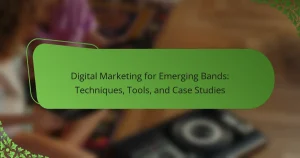Indie music collaboration platforms enhance creativity and connectivity among artists. They offer user-friendly interfaces, real-time collaboration tools, and access to diverse resources. Users experience seamless communication and project management features that streamline creative processes. Regional variations and innovative trends further shape these platforms, influencing user experiences and collaboration dynamics.
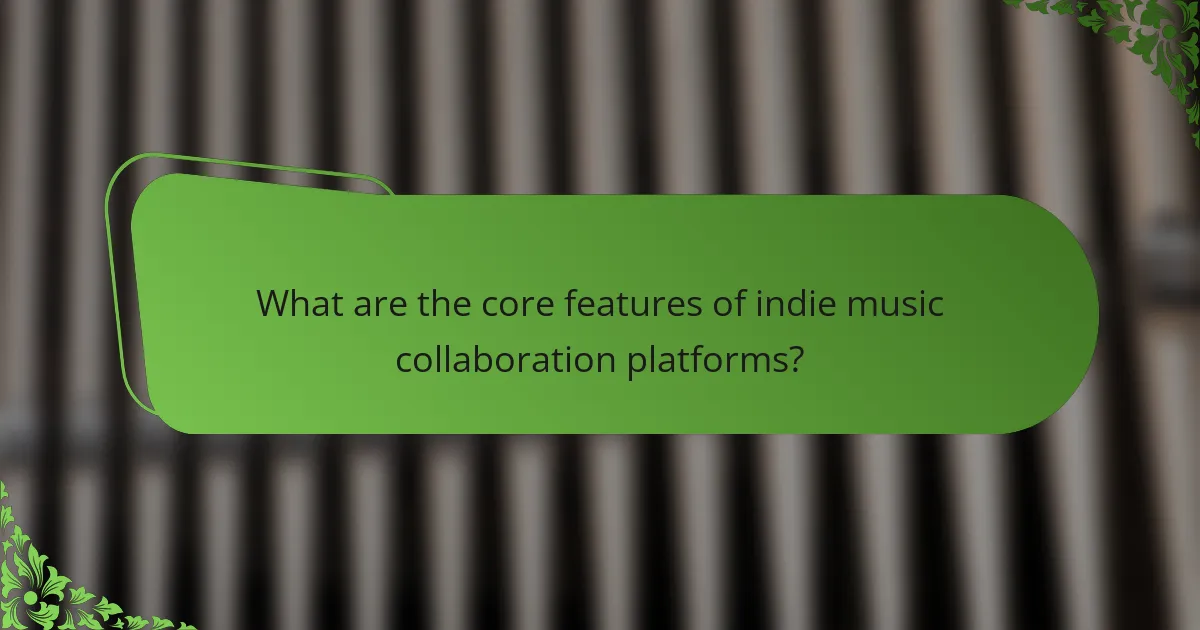
What are the core features of indie music collaboration platforms?
Indie music collaboration platforms offer features that enhance creativity and connectivity among artists. Key features include user-friendly interfaces, real-time collaboration tools, and integrated communication channels. These platforms often provide access to a diverse network of musicians, enabling genre-blending and innovative projects. Unique attributes may include customizable workflows and project management tools tailored for music creation, enhancing user experience. Additionally, some platforms feature exclusive resources like tutorials and industry insights, which are rare in conventional music platforms.
How do these features enhance user creativity and collaboration?
Indie music collaboration platforms enhance user creativity and collaboration by offering features like real-time editing, diverse genre integration, and community feedback. These attributes foster an environment where artists can experiment and refine their work collaboratively. For instance, real-time editing allows multiple users to contribute simultaneously, sparking new ideas and approaches. Additionally, genre integration encourages cross-genre experimentation, expanding creative boundaries. Community feedback provides constructive insights, helping artists improve their projects and connect with like-minded individuals.
Which tools are most commonly integrated into these platforms?
The most commonly integrated tools in indie music collaboration platforms include digital audio workstations, file-sharing services, communication apps, project management tools, and social media integration. These tools enhance collaboration efficiency and streamline the creative process for artists.
What security measures do these platforms implement to protect user content?
Indie music collaboration platforms implement various security measures to protect user content, including encryption, user authentication, and regular security audits. These measures ensure that user data remains confidential and secure from unauthorized access. Additionally, many platforms provide backup solutions to prevent data loss.
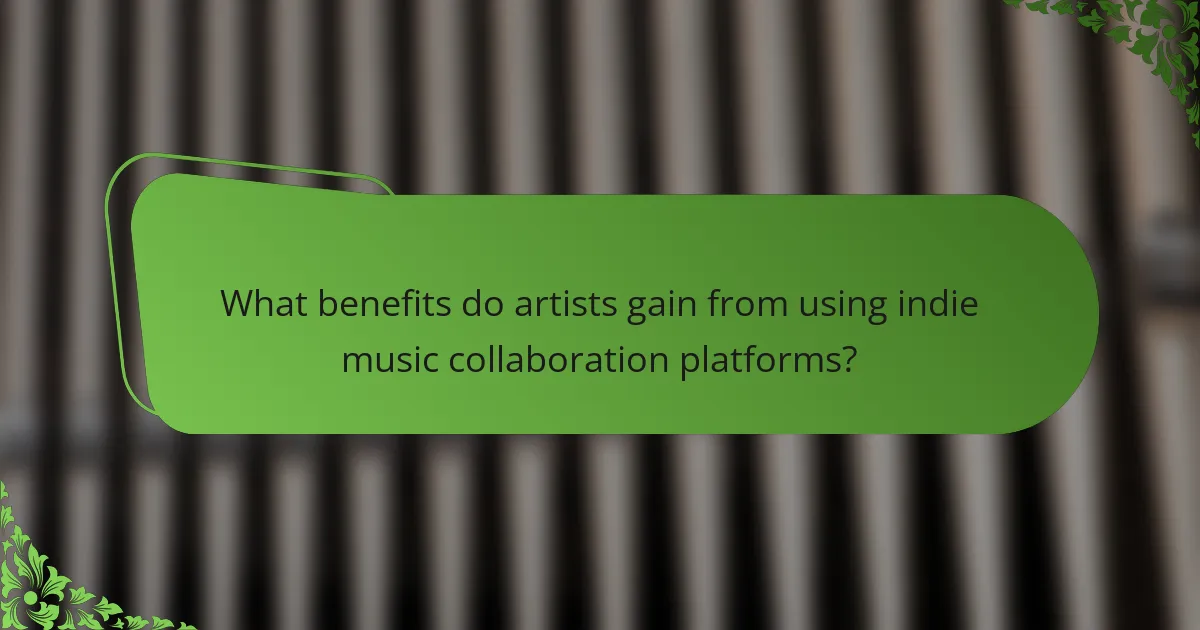
What benefits do artists gain from using indie music collaboration platforms?
Artists gain enhanced exposure, collaboration opportunities, and access to diverse resources by using indie music collaboration platforms. These platforms connect artists with like-minded individuals, enabling creative partnerships that may not have been possible otherwise. They often feature tools for project management, file sharing, and networking. As a result, artists can streamline their creative processes and reach wider audiences, ultimately benefiting their careers.
How do these platforms facilitate networking opportunities for musicians?
Indie music collaboration platforms facilitate networking opportunities for musicians by connecting them with like-minded artists, producers, and industry professionals. These platforms often feature user profiles, collaboration tools, and community forums that enhance interaction. For instance, musicians can share their work, receive feedback, and find collaborators for projects. Additionally, many platforms host events or competitions, further expanding networking possibilities. Ultimately, these features foster a supportive environment that encourages creative partnerships and professional growth.
In what ways do they support independent music distribution?
Indie music collaboration platforms support independent music distribution by providing tools for artists to share and promote their work. These platforms often include features like direct-to-fan sales, social media integration, and analytics to track engagement. Additionally, they facilitate networking opportunities among musicians, enabling collaborations that can enhance visibility and reach. By streamlining the distribution process, these platforms empower artists to maintain control over their music while maximizing exposure.
What role do collaboration platforms play in promoting diversity in music?
Collaboration platforms foster diversity in music by providing accessible spaces for artists from various backgrounds to connect. These platforms enable collaboration across genres, allowing unique cultural influences to merge. Features like user-friendly interfaces and diverse networking options enhance participation from underrepresented groups. As a result, indie music thrives through innovative partnerships, showcasing a broader spectrum of voices.
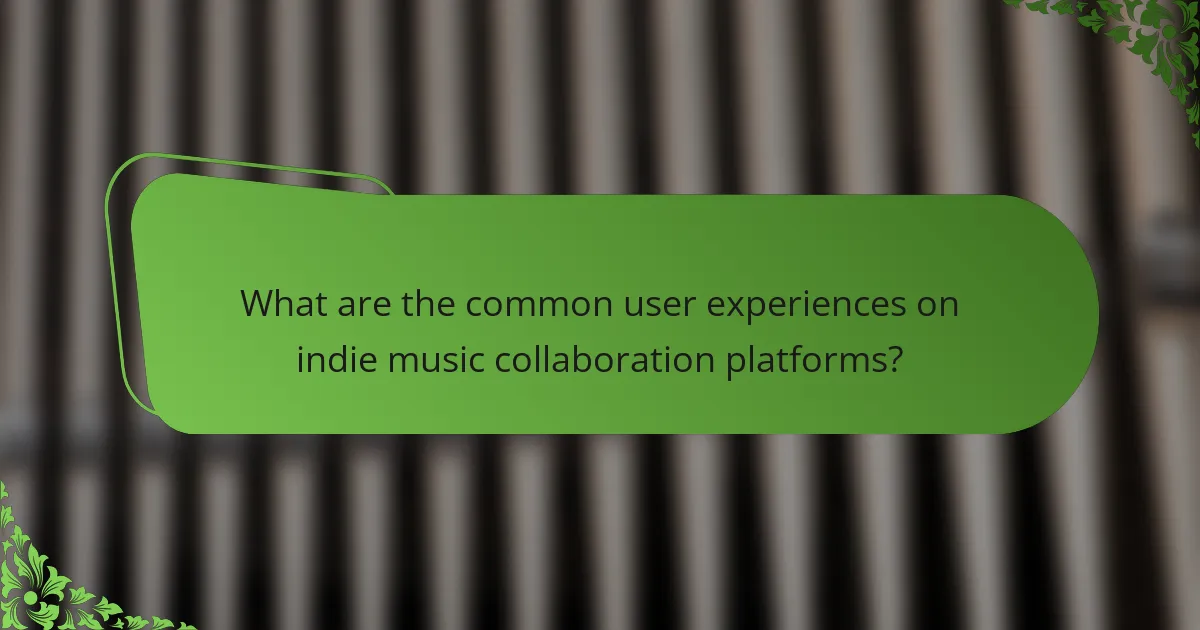
What are the common user experiences on indie music collaboration platforms?
Common user experiences on indie music collaboration platforms include seamless communication, diverse collaboration tools, and a supportive community. Users often appreciate features like real-time feedback, project management tools, and the ability to connect with artists globally. These platforms foster creativity and provide opportunities for skill development. Additionally, users value the accessibility of resources and the chance to showcase their work to a wider audience. Overall, these experiences enhance collaboration and artistic growth.
How do users perceive the onboarding process across different platforms?
Users generally perceive the onboarding process on indie music collaboration platforms as intuitive and user-friendly. Positive experiences often stem from clear instructions and engaging tutorials.
Platforms like Soundtrap and BandLab utilize interactive elements to facilitate learning. For instance, users appreciate step-by-step guides that simplify complex features.
Conversely, some platforms may overwhelm users with excessive information or complicated interfaces, leading to frustration. A streamlined onboarding experience enhances user retention and satisfaction.
Overall, effective onboarding is crucial for fostering a positive user experience and encouraging collaboration among musicians.
What challenges do users frequently encounter while collaborating online?
Users frequently encounter challenges such as communication barriers, file compatibility issues, and differing software preferences while collaborating online. These obstacles can hinder the creative process and lead to frustration among indie musicians. Additionally, time zone differences may complicate synchronous collaboration, affecting project timelines. Users may also struggle with the learning curve associated with new platforms, which can slow down productivity.
Which platforms receive the highest satisfaction ratings from users?
Indie music collaboration platforms with the highest user satisfaction ratings include BandLab, Soundtrap, and Splice. These platforms excel in features like ease of use, collaborative tools, and community engagement, leading to positive user experiences. BandLab stands out with its comprehensive music creation tools and social networking features. Soundtrap offers seamless integration with various devices, enhancing accessibility. Splice is praised for its extensive sample library and intuitive interface, making music collaboration enjoyable for users.
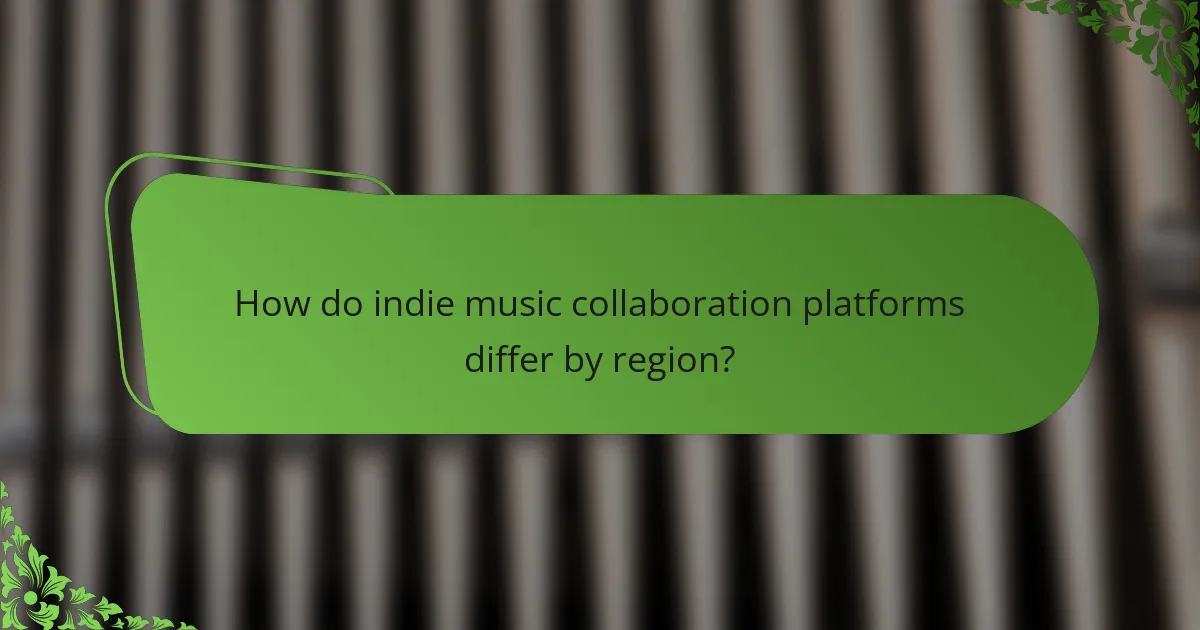
How do indie music collaboration platforms differ by region?
Indie music collaboration platforms vary significantly by region, influenced by local music scenes and cultural preferences. For instance, North American platforms often emphasize genre diversity and networking opportunities, while European platforms may focus on artistic collaboration and funding access. In Asia, platforms frequently cater to emerging markets, offering mobile-friendly features to engage younger audiences. Additionally, regional regulations can shape platform functionalities, affecting user experiences and collaboration dynamics.
What unique features are tailored for users in specific cultural contexts?
Indie music collaboration platforms often include unique features tailored for specific cultural contexts, enhancing user experiences. These features may involve localized content, community engagement tools, and culturally relevant collaboration options. For instance, platforms may offer language support that aligns with regional dialects or provide access to culturally specific music genres. Additionally, they might facilitate networking opportunities that connect users with local artists and industry professionals, fostering a sense of community and collaboration.
How do user behaviors vary across different countries?
User behaviors on indie music collaboration platforms vary significantly across countries due to cultural influences and technological access. For instance, North American users often prioritize networking and collaboration features, while European users may focus on music discovery and streaming capabilities. In Asia, mobile accessibility is crucial, leading to higher engagement on platforms optimized for smartphones. These differences illustrate how regional preferences shape user experiences and platform features.
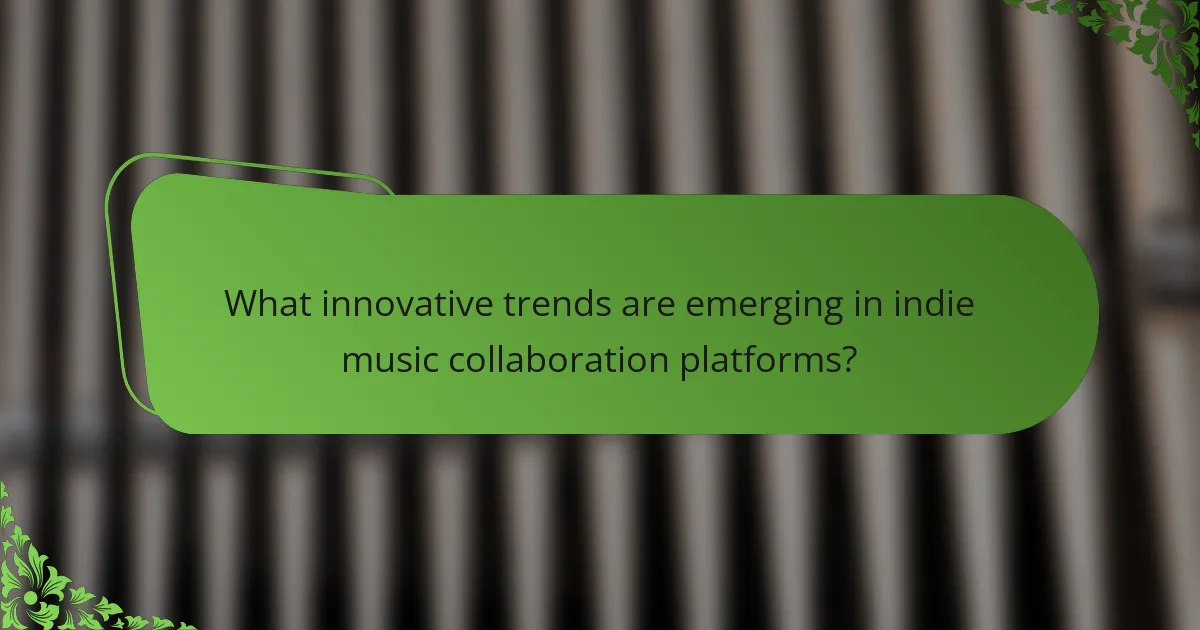
What innovative trends are emerging in indie music collaboration platforms?
Innovative trends in indie music collaboration platforms include enhanced virtual reality experiences, AI-driven music creation tools, and decentralized distribution methods. These advancements foster creativity and streamline collaboration among artists. Platforms are increasingly integrating blockchain technology for transparent royalty distribution, allowing artists to retain more control over their work. Additionally, community-driven features, such as collaborative playlists and live-streaming sessions, are becoming more prominent, enhancing user engagement and interaction.
How are AI and machine learning shaping the future of music collaboration?
AI and machine learning are revolutionizing music collaboration by enhancing creativity and streamlining processes. These technologies facilitate remote collaboration, enabling artists to connect globally and share ideas seamlessly. Machine learning algorithms analyze trends, helping musicians create music that resonates with audiences. AI tools assist in generating melodies, harmonies, and even lyrics, expanding artistic possibilities. Platforms leveraging these technologies provide features like real-time feedback and automated mixing, improving user experiences. As a result, indie musicians can collaborate more effectively, fostering innovation and diversity in music creation.
What role do social media integrations play in user engagement?
Social media integrations significantly enhance user engagement on indie music collaboration platforms. They facilitate communication, promote sharing, and foster community building among users. By allowing artists to share their work across various platforms, these integrations increase visibility and interaction. For example, platforms that connect with Instagram or Facebook enable users to showcase their projects and receive immediate feedback. This real-time interaction can lead to higher user retention and collaboration opportunities. Overall, effective social media integration serves as a vital attribute for boosting engagement and expanding user networks in the indie music scene.
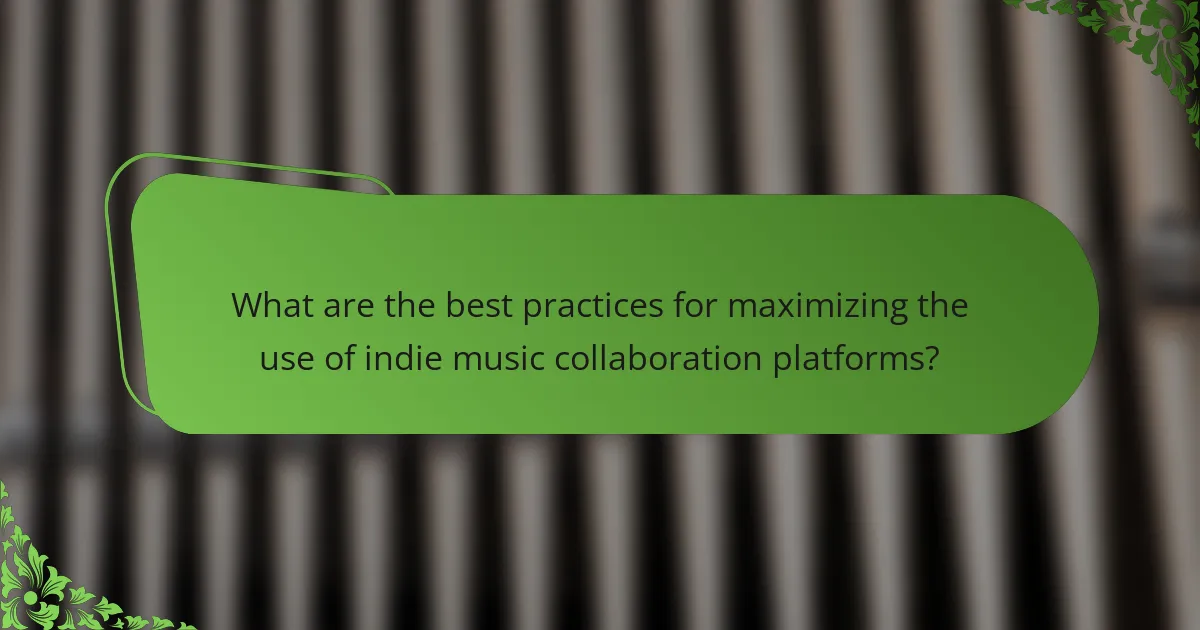
What are the best practices for maximizing the use of indie music collaboration platforms?
To maximize the use of indie music collaboration platforms, users should focus on effective networking, clear communication, and utilizing platform features. Engaging actively with other musicians enhances creativity and collaboration opportunities. Utilize tools for project management to streamline workflows. Regularly update profiles to attract potential collaborators. Explore diverse genres to expand musical influences and reach.
What strategies can artists employ to enhance their collaborative projects?
Artists can enhance their collaborative projects by leveraging indie music collaboration platforms effectively. These platforms offer features like real-time collaboration tools, project management options, and community feedback, which streamline the creative process.
Utilizing these features encourages better communication among artists, fostering a collaborative spirit. Additionally, platforms often provide access to a wider audience, increasing exposure and potential listener engagement.
Artists should also actively participate in community discussions to share experiences and gain insights from peers. This interaction can lead to valuable networking opportunities and collaborative ventures.
Finally, artists should experiment with different platforms to find the one that best suits their unique needs and collaborative style, enhancing overall project outcomes.
Which common mistakes should users avoid when using these platforms?
Users should avoid common mistakes like neglecting platform features, failing to communicate clearly, and not researching collaborators. Misunderstanding copyright terms and ignoring feedback can hinder successful collaborations. Additionally, users should not overlook the importance of setting clear goals and timelines.
What expert tips can help optimize collaboration experiences?
Utilizing expert tips can significantly enhance collaboration experiences on indie music platforms. Focus on clear communication, set defined goals, and leverage platform features effectively. Regular feedback and adaptability to changes are essential for successful outcomes. Engage with community resources to maximize collaboration benefits.


